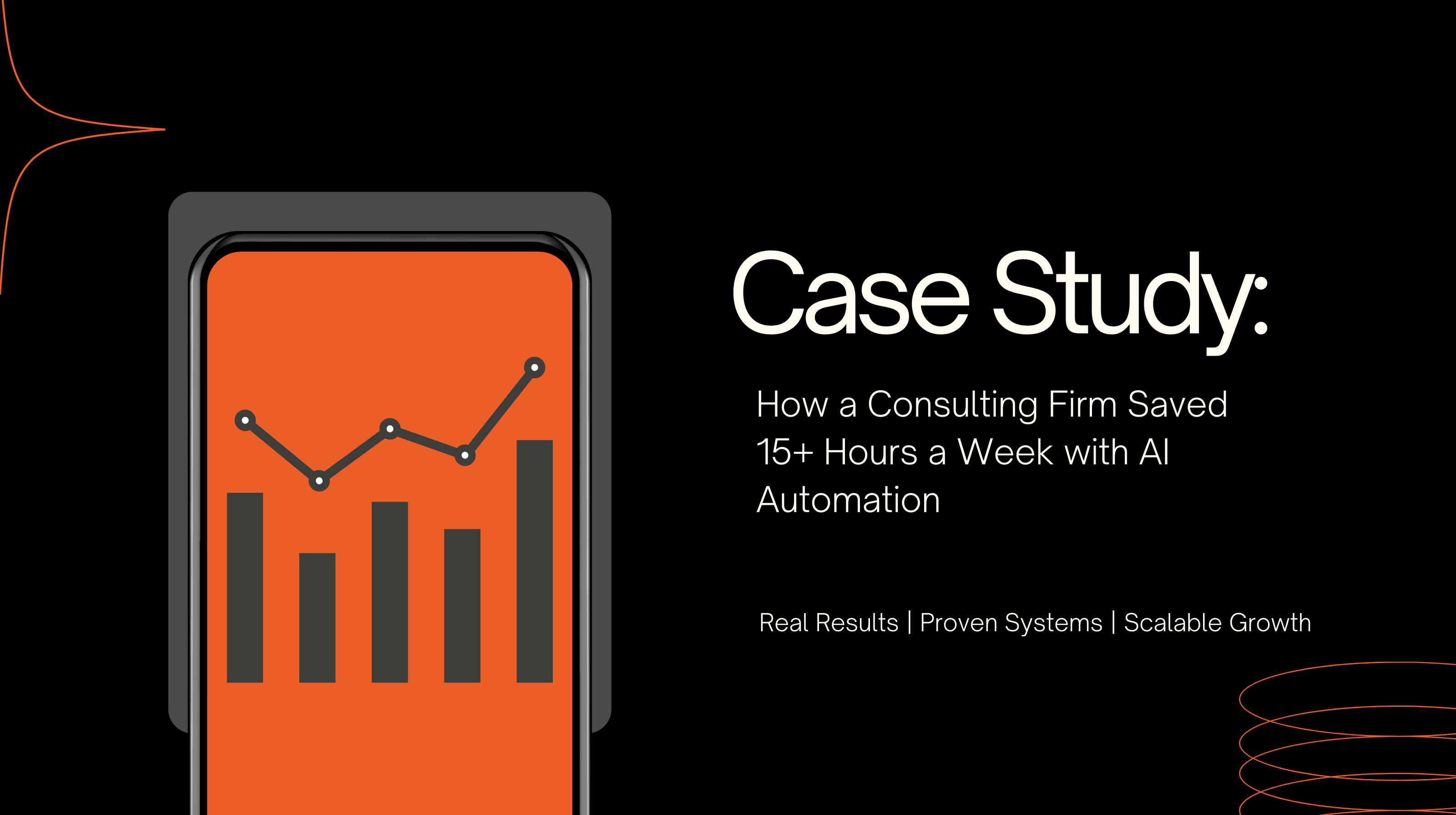Automation ROI measures how much your automation investment pays off financially and operationally. It’s not just about cutting costs - it’s about improving productivity, reducing errors, scaling efficiently, and driving revenue. Businesses using automation often see ROI of 240% within 6–9 months, with process costs reduced by 30–50%. To calculate and track ROI effectively, focus on these six key metrics:
Start by setting clear goals, collecting baseline data, and aligning metrics with your business priorities. Use the formula ROI = ((Net Benefit - Cost of Investment) / Cost of Investment) × 100 to calculate results. Automation can save up to 75% on manual tasks while improving quality and performance, making it a key driver for long-term growth.
How to Create Automation Project KPI Metrics for ROI Success
Setting Up Baseline and Objectives
To effectively measure the ROI of automation, you first need to establish a solid starting point. This involves setting clear objectives and gathering accurate data about your current processes. Without these foundational steps, it’s impossible to determine if your automation efforts are delivering results.
Defining Automation Goals
Clear, measurable goals are the backbone of any successful automation initiative. To ensure your objectives are well-defined and actionable, use the SMART framework - Specific, Measurable, Achievable, Relevant, and Time-bound. This approach ensures your efforts align with your business needs and have a clear purpose.
Start by analyzing your current processes to identify areas where automation can make a difference. Look for repetitive tasks, frequent errors, or bottlenecks that slow things down. Bring your entire team into the conversation - this includes business leaders, developers, and QA teams - to set meaningful goals.
Once you’ve had these discussions, document your primary project goal. Then, break it down into smaller, actionable objectives that address your most pressing challenges. For instance, if improving customer satisfaction is a priority, you might aim to boost customer satisfaction by 20% within the next quarter by automating specific customer service tasks. This goal is specific (20% improvement), measurable (via satisfaction surveys), achievable (based on current performance), relevant (tied to business priorities), and time-bound (one quarter).
Tailor your objectives to match your operational priorities, whether that’s cutting costs, improving productivity, or enhancing quality. These goals should directly connect to measurable outcomes, giving you a clear way to evaluate success.
With your goals in place, the next step is gathering baseline data to track your progress.
Collecting Baseline Data
Baseline data is essential for understanding the impact of automation. It provides a snapshot of how your processes perform before any changes are made, serving as a reference point for comparison. This includes metrics like costs, cycle times, and error rates.
Start by identifying all the data sources related to the process you’re automating. These might include databases, application logs, user inputs, or sensor data. Use tools like automated data extraction or API integrations to minimize human error during collection.
Take this example: A manufacturer recorded manual inspection costs of $100,000 annually, with an 85% defect detection rate and 50 units inspected per hour. This detailed baseline allowed them to measure the precise impact of automation.
To ensure your data is reliable, implement validation checks. This could include verifying completeness, consistency, and proper formatting, along with setting up alerts for anomalies. Regular audits can catch and correct discrepancies before they skew your ROI calculations.
Consistency is key. Standardize your data collection methods across the project and train team members on proper data management practices. As your project evolves, update these methods to maintain accuracy.
In the manufacturer’s case, automation reduced inspection costs to $50,000 annually, increased defect detection to 98%, and boosted inspection speed to 200 units per hour. This clear comparison revealed $50,000 in annual savings and a 13% improvement in defect detection.
Accurate baseline data lays the groundwork for aligning metrics with your business goals.
Matching Metrics with Business Goals
After setting goals and collecting baseline data, the next step is to align your metrics with your organization’s priorities. The right metrics ensure that your automation investments deliver measurable value. Different businesses will prioritize different metrics based on their specific challenges and objectives.
Focus on metrics that directly support your goals, whether it’s cost reduction, productivity gains, revenue growth, or compliance improvements. These metrics should be measurable through automated systems, enabling regular progress updates for leadership.
Consider how metrics affect different parts of your business. Some may improve productivity, others might enhance delivery speed, and still others could strengthen compliance or security. Each area requires its own measurement and reporting approach.
For example, a healthcare application achieved 95% defect detection efficiency, meeting strict industry standards. Similarly, a telecom company improved test coverage by 70%, significantly reducing customer-reported issues.
"Automation is not just about running tests; it's about delivering value." - Beatriz Biscaia, Content Marketing Specialist at Xray
Choose KPIs that clearly indicate success and align with both your team’s goals and your broader business objectives. Metrics like defect detection rates or direct ROI from automation are particularly useful for tracking progress. Automated testing, for instance, can improve defect detection by up to 90% compared to manual testing, making quality metrics especially impactful for many organizations.
Setting objectives and KPIs at the start of your project ensures that your efforts lead to tangible improvements in efficiency and quality. This alignment between metrics and business goals creates a clear path for demonstrating the value of your automation investments.
6 Key Metrics for Measuring Automation ROI
With your baseline established and metrics aligned to business goals, it's time to explore six key metrics that effectively evaluate automation ROI. These metrics provide a clear, measurable view of the value automation brings to your operations.
Cost Savings
Cost savings focus on reducing expenses in labor, operations, and overhead through automation.
Labor cost savings are central to most automation ROI calculations. To measure this, calculate the hourly rate of employees performing tasks that will be automated, then multiply it by the hours spent on those tasks. For example, in 2015, the average U.S. manufacturing labor cost was $38 per hour, rising to $42.60 by 2019. Automation can cut these expenses by up to 30%.
Include both direct and indirect labor costs - such as errors, downtime, and unscheduled breaks - to get a complete picture. Research shows that 13% of employee productivity is lost to distractions like social media.
Operational cost reductions go beyond labor. Review your history for expenses tied to machine breakdowns, errors, or inefficiencies that automation can address. For instance, a retail chain that automated inventory management reduced operational costs by 30% and increased inventory turnover by 20% within a year.
Productivity Improvement
Productivity improvements measure how automation helps your team achieve more in less time by comparing resource input to output over a set period.
Time-based metrics and output volume provide a clear picture of productivity gains. Compare task completion times before and after automation and track throughput increases. For example, a manufacturing firm using robotics boosted output by 50% and reduced defects by 70%. Automation can raise productivity by 20–25% on average.
Resource utilization improvements highlight better use of equipment, materials, and personnel. A mid-sized logistics company processed 30% more orders and reduced delivery times by 25% after automating its operations.
Automation tools with built-in analytics can track these metrics, helping you assess improvements and identify opportunities for further gains.
Error Reduction
Error reduction measures automation's ability to minimize manual mistakes, rework, and compliance issues, impacting both cost and quality outcomes.
Defect detection improvements demonstrate how automation catches errors that humans might miss. Studies link 66% to 80% of downtime incidents to human error. Automated systems ensure consistent quality control, reducing such interruptions.
Reducing manual errors can lead to significant savings. For instance, a manufacturing company that automated its data processes saw operational costs drop by 15% in a year. Similarly, Robotic Process Automation (RPA) has helped companies cut operational costs by 40%.
Quality consistency is another key benefit. Nearly 90% of workers trust automation to deliver error-free results and support faster decision-making.
To measure error reduction, use monitoring tools to track variables like temperature, power loads, or anomalies that cause downtime. Analytics and KPIs can further assess process success and uncover new automation opportunities.
Scalability
Scalability evaluates how well your automation system can grow with your business without requiring proportional increases in resources or costs.
System capacity expansion shows how automation handles growing workloads without additional human input, enabling efficient scaling.
Resource allocation efficiency highlights how automation optimizes existing resources to support growth.
Flexible deployment capabilities measure how easily automation can be replicated across departments or locations. Currently, 70% of organizations using automation report notable improvements in efficiency and accuracy.
Assess scalability by examining your system's ability to handle peak loads, adapt to new demands, and integrate future technologies. Many companies recoup their automation investment in 1 to 3 years, depending on the scale and industry.
Revenue Impact
Automation doesn't just save costs - it also drives business growth. Revenue impact measures how automation increases sales, speeds up time-to-market, and enhances customer satisfaction.
Sales performance improvements are a significant driver. For example, an e-commerce retailer using a comprehensive CRM saw customer retention rates jump by 50%, contributing to higher lifetime value and revenue growth.
Time-to-market acceleration highlights how automation speeds up product development and delivery, enabling businesses to seize opportunities faster and respond to customer needs effectively.
Customer satisfaction gains foster repeat business and referrals. Some companies have reported a 200% return on investment within the first year of automation, largely due to enhanced customer experiences.
Track metrics like sales per employee, conversion rates, and customer lifetime value to connect revenue growth directly to automation.
Operational Efficiency
Operational efficiency measures how automation improves workflows, reduces delays, and eliminates bottlenecks.
Workflow optimization removes unnecessary steps, streamlining processes. For instance, DCIM software automates tasks like performance monitoring and incident response.
Resource utilization improvements ensure better allocation of time, materials, and personnel. Automation can increase productivity by up to 40% over five years.
Process standardization ensures consistent execution across operations, supporting uniform security policies and automatic updates, which enhance overall security.
Monitor efficiency through dashboards tracking metrics like reduced manual processing time, cost savings, and customer satisfaction. Process mining can also uncover gaps and new optimization opportunities.
"Data center automation implements the latest technologies to improve operational efficiency with less human intervention." – Volico
sbb-itb-d7ea0c6
Calculating and Reporting ROI
After gathering data from the six key metrics, the next step is turning that information into a clear calculation of your automation ROI. This step is crucial - it transforms raw numbers into insights that can guide strategic decisions and win over stakeholders.
Basic ROI Formula
At its core, the formula for ROI is:
ROI = ((Net Benefit - Cost of Investment) / Cost of Investment) × 100
To use this formula, start by listing all the costs associated with your project. This includes direct expenses like hardware and software licenses, as well as indirect costs such as training and implementation time. Then, estimate the financial gains from automation, whether through higher revenues or lower expenses.
Here’s an example: A company purchases a $50,000 robot to operate across three shifts daily, requiring one operator per shift. The total system cost is $150,000 ($50,000 × 3). Without automation, labor costs amount to $300,000 annually (3 operators × $100,000 per operator). With the robot in place, labor costs drop to $75,000, saving $225,000. This results in a first-year ROI of $75,000 ($225,000 - $150,000).
Different types of projects might call for tailored ROI calculations. For instance:
Once you’ve calculated your basic ROI, the next step is integrating this with the six key metrics.
Combining Metric Results
To create a unified view of your automation's impact, translate each metric into dollar values. This allows you to compare and aggregate benefits across different areas.
For example, one manufacturing company automated its quality control process. Before automation, manual inspection cost $100,000 annually, detected 85% of defects, and processed 50 units per hour. After automation, costs dropped to $50,000 annually, defect detection improved to 98%, and throughput increased to 200 units per hour. The combined benefits included $50,000 in cost savings, productivity gains equating to 300,000 additional units inspected annually, and a 13% boost in quality.
When combining results, it’s important to separate direct savings - such as immediate cost reductions - from indirect benefits like productivity improvements or higher quality. Direct savings are straightforward to measure, while indirect benefits may require adjustments to account for factors like employee motivation or operational variability.
Reporting to Decision-Makers
Once you’ve quantified the benefits, presenting your findings effectively is key. A well-structured report not only validates your automation investment but also helps decision-makers see the big picture. Focus on a few major benefits rather than overwhelming your audience with minor details. Use hard data to clearly demonstrate the impact and ROI.
Organize your presentation with a clear agenda:
"The presentation must be planned with a specific strategy in mind." - Jack J. Phillips, Ph.D., Chairman of ROI Institute, Inc.
"Executives care very little about reactive-type or anecdotal data...they are more interested in quantitative data that focuses on impact and ROI." - Jack J. Phillips, Ph.D., Chairman of ROI Institute, Inc.
Keep your delivery precise and free of jargon. Stick to the numbers that matter most and rehearse your presentation beforehand. After the meeting, share a complete report and outline specific recommendations for further improvements. Use this opportunity to discuss how ROI analysis can continue to guide optimization efforts.
Automation has the potential to reduce costs by 40% to 75% by cutting down on manual tasks, identifying inefficiencies, minimizing errors, and enhancing employee productivity. Frame your findings within this broader context to emphasize the value of your automation investment.
Using Devcore Solutions for Automation ROI

Tracking and maximizing your automation ROI requires more than just implementing technology - it demands the right tools and a clear framework. Devcore's AI-powered automation systems are designed to not only streamline processes but also quantify their impact. By aligning directly with the six key metrics discussed earlier, Devcore ensures every automation project delivers measurable results. Let’s explore how their tools and strategies drive real ROI.
Devcore's ROI Tracking Tools
Devcore integrates robust tracking features into its automation systems, allowing businesses to monitor metrics like cost savings, productivity improvements, error reduction, and operational efficiency - taking the guesswork out of ROI calculations.
Their system tracks both objective data (e.g., uptime, response times, failure rates) and subjective feedback from team members, creating a well-rounded view of automation’s impact. This dual approach mirrors how top-performing DevOps teams achieve exceptional results, such as reducing lead times by over 2,500 times compared to lower performers, all through consistent measurement and refinement.
For companies aiming to define and measure positive ROI, Devcore’s tools connect automation goals directly to their financial and operational value. Automated reports translate technical improvements into clear dollar amounts, making it easy to showcase ROI to stakeholders.
Maximizing ROI with the Leverage Blueprint™
At the core of Devcore's approach is their Leverage Blueprint™, a proprietary framework designed to identify inefficiencies and craft tailored automation solutions that deliver measurable outcomes. This blueprint systematically maps out operational bottlenecks and builds automation systems to eliminate them.
The results speak for themselves: the Leverage Blueprint™ has driven over $10 million in additional revenue through AI-powered automation. For instance:
"We build systems that find cash, kill inefficiencies, and give you an unfair advantage." - Devcore
The Leverage Blueprint™ ensures every automation initiative aligns with business objectives, tracks ROI effectively across all six metrics, and compounds efficiency gains over time.
Custom Solutions for Scalable Results
Devcore combines its proven tracking tools and blueprint strategies with fully customized solutions designed to grow with your business. Unlike generic automation tools, Devcore creates systems specifically tailored to your operational needs and ROI goals.
Their offerings include three tailored plans:
This personalized approach ensures that every solution functions as a profit center rather than just another expense. As Devcore puts it:
"For our best clients, we're not a line item, we're a profit center." - Devcore
Each solution is built with ROI tracking integrated from the very beginning. Whether it’s automating CRM updates, improving lead research, developing AI tools for decision-making, or optimizing workflows through API integrations, every system is designed to measure its impact across key metrics like cost savings, productivity, and scalability.
What’s more, these custom solutions evolve alongside your business. Instead of plateauing after implementation, they continue to deliver growing efficiency and ROI over time. This scalability is essential for businesses aiming to maximize their automation investments and achieve long-term success.
"Every hour you wait is an hour wasted. Time compounds. Efficiency compounds. Money saved today turns into profits tomorrow. Operators who wait get outpaced. Operators who act win." - Devcore
Conclusion
Measuring automation ROI lays the groundwork for long-term growth. The six key metrics we've discussed offer a well-rounded framework that goes beyond just cutting costs. Companies adopting this approach experience 40% higher returns on their automation investments compared to those focusing solely on cost reduction.
Key Takeaways
The six metrics - cost savings, productivity improvement, error reduction, scalability, revenue impact, and operational efficiency - work together to highlight the full value of automation in reshaping business operations.
Cost savings, paired with enhanced productivity and reduced errors, deliver measurable ROI. As Taras Oleksyn, AQA Lead at TestFort, puts it:
"ROI from test automation is directly linked to the speed of delivery - automation helps companies release new features and fixes quickly, enabling them to meet market demands more efficiently and stay ahead of competitors".
Employee feedback supports these findings: nearly 90% of workers believe automation helps them work faster, avoid errors, and make better decisions.
Metrics like scalability and revenue impact highlight the long-term benefits of automation. For instance, the automation testing market exceeded $15 billion in 2020 and is projected to grow at an annual rate of over 16% through 2027.
Real-world examples back this up. Roamler avoided hiring 15 additional employees, saving over $300,000 annually while cutting error rates by 64%. Similarly, Ynvolve reduced quote creation time by 90%, saving $30,000 monthly and forecasting 50% revenue growth.
This comprehensive approach underscores the importance of tracking all six metrics to maximize ROI. These insights align closely with Devcore's tools, which are designed to help businesses monitor and optimize automation performance.
Next Steps for Businesses
To put these insights into action, businesses should start by establishing clear benchmarks. Define success metrics that align with your goals and track progress over time.
Make measurement tools a core part of your automation strategy from the beginning. Identify key processes, involve stakeholders, and design systems for continuous improvement.
Devcore's solutions can help accelerate this journey. Their integrated tools monitor all six metrics, providing a systematic way to track and enhance your automation efforts.
With the automation testing market growing rapidly and real-world results proving the value of comprehensive ROI measurement, there's no better time to act. Nearly 80% of employees say automation gives them more time for strategic tasks, customer engagement, and skill development.
The next step is simple: evaluate your current processes, set baseline measurements, and start tracking the six key metrics. Whether you choose Devcore’s Starter Plan at $1,200/month or scale up with an Enterprise solution, the key is to begin. Businesses that act now will position themselves as leaders in tomorrow’s competitive landscape.
FAQs
How can businesses ensure their automation goals align with their overall strategy?
To make sure your automation efforts align with your business strategy, start by identifying your company’s main goals. Whether you’re aiming to improve efficiency, boost customer satisfaction, or reduce costs, your automation projects should directly support these priorities. Focus on processes that have the most impact and can provide measurable outcomes.
Collaboration is key here. Bring together teams from different departments to gain insights into how automation can solve specific challenges they face. Also, set clear key performance indicators (KPIs) to monitor progress and measure success. Regularly review these metrics to ensure your automation efforts stay on track and continue to support your long-term objectives.
What challenges do companies face when gathering baseline data for automation ROI, and how can they address them?
One of the biggest hurdles companies face is getting a clear picture of how their processes are currently performing. Inconsistent data collection methods or incomplete documentation can muddy the waters, making it tough to pinpoint a solid starting point. And without dependable baseline data, gauging the real impact of automation efforts becomes nearly impossible.
To tackle this, businesses should focus on a few key steps: standardize how data is collected, make sure every existing process is fully documented, and rely on reliable tools to gather consistent, accurate information. By doing this groundwork, companies can set a solid stage for measuring ROI and ensure that the benefits of automation are not just visible but also quantifiable.
How does Devcore's Leverage Blueprint™ help businesses achieve better ROI from automation projects?
Devcore's Leverage Blueprint™ is crafted to help businesses get the most out of automation by aligning their automation strategies with clear business goals. It offers a structured approach to optimize workflows, cut down on inefficiencies, and monitor progress using key performance metrics.
By concentrating on measurable results - such as cutting costs, boosting productivity, and minimizing errors - the Leverage Blueprint™ ensures automation efforts create real, impactful benefits. Its practical insights enable businesses to make informed decisions and expand their operations with confidence.
Related posts
- Best AI Integration Platforms for Mid-Size Firms
- Ultimate Guide to Scaling Business with Automation
- 5 Steps to Build an Automation Roadmap
- Custom Automation for Operational Efficiency: Success Stories
{"@context":"https://schema.org","@type":"FAQPage","mainEntity":[{"@type":"Question","name":"How can businesses ensure their automation goals align with their overall strategy?","acceptedAnswer":{"@type":"Answer","text":"<p>To make sure your automation efforts align with your business strategy, start by identifying your company’s main goals. Whether you’re aiming to improve efficiency, boost customer satisfaction, or reduce costs, your automation projects should directly support these priorities. Focus on <strong>processes that have the most impact</strong> and can provide measurable outcomes.</p> <p>Collaboration is key here. Bring together teams from different departments to gain insights into how automation can solve specific challenges they face. Also, set clear <strong>key performance indicators (KPIs)</strong> to monitor progress and measure success. Regularly review these metrics to ensure your automation efforts stay on track and continue to support your long-term objectives.</p>"}},{"@type":"Question","name":"What challenges do companies face when gathering baseline data for automation ROI, and how can they address them?","acceptedAnswer":{"@type":"Answer","text":"<p>One of the biggest hurdles companies face is getting a clear picture of how their processes are currently performing. Inconsistent data collection methods or incomplete documentation can muddy the waters, making it tough to pinpoint a solid starting point. And without dependable baseline data, gauging the real impact of automation efforts becomes nearly impossible.</p> <p>To tackle this, businesses should focus on a few key steps: <strong>standardize how data is collected</strong>, make sure every existing process is fully documented, and rely on reliable tools to gather consistent, accurate information. By doing this groundwork, companies can set a solid stage for measuring ROI and ensure that the benefits of automation are not just visible but also quantifiable.</p>"}},{"@type":"Question","name":"How does Devcore's Leverage Blueprint™ help businesses achieve better ROI from automation projects?","acceptedAnswer":{"@type":"Answer","text":"<p>Devcore's <strong>Leverage Blueprint™</strong> is crafted to help businesses get the most out of automation by aligning their automation strategies with clear business goals. It offers a structured approach to optimize workflows, cut down on inefficiencies, and monitor progress using <strong>key performance metrics</strong>.</p> <p>By concentrating on measurable results - such as cutting costs, boosting productivity, and minimizing errors - the Leverage Blueprint™ ensures automation efforts create real, impactful benefits. Its practical insights enable businesses to make informed decisions and expand their operations with confidence.</p>"}}]}




